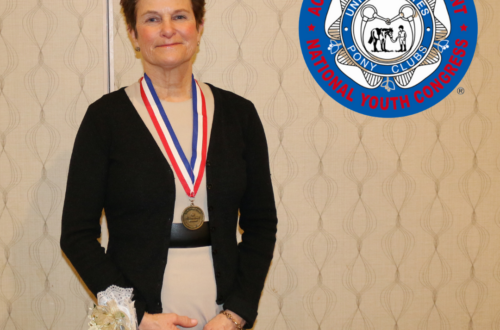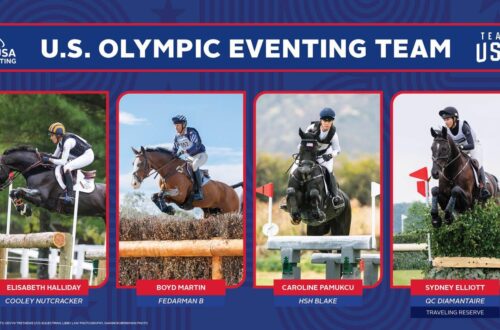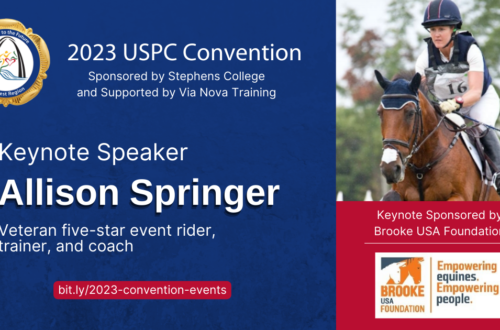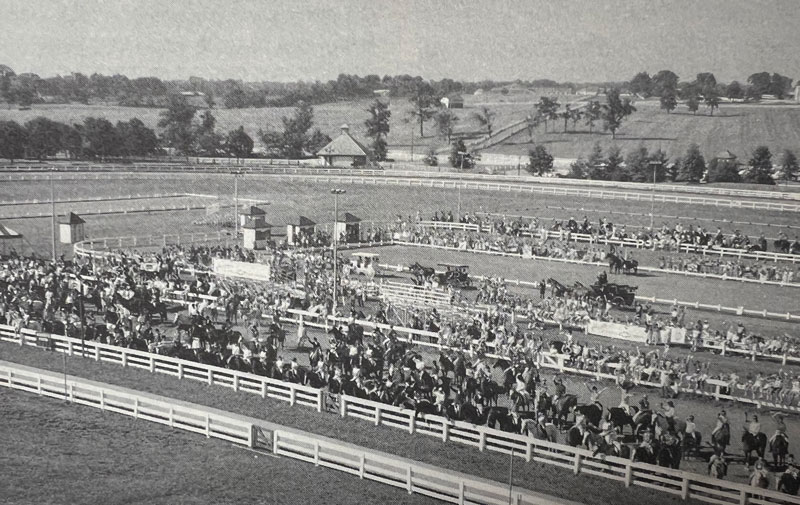
Pony Club Newsletter Notes from the 1980s: A Decade of Development
By Sarah Evers Conrad, USPC Marketing and Communications Director
A lot can happen in 10 years for an organization. As evidenced in the Pony Club News newsletter, the 1980s were transformative years for the United States Pony Clubs, marked by significant organizational changes with the National Office, leadership, and the committees; the introduction of what is now an iconic event—Pony Club Festival (now called USPC Festival); changes to other championships; the continuation of many international exchanges; and a focus on safety and education. As the organization expanded, so did the USPC newsletter, reaching upwards of 20 pages. Read on to learn about some of the interesting changes in the 1980s that I discovered during my journey through the 1980s newsletters.
Changes to Championships
While the USPC Board of Governors had already rebranded the “National Rally” to the “National Combined Training Rally” in 1978, another change came in 1981 when it was rebranded yet again as the “National Combined Training Championships,” and the event was split into two separate events: the Combined Training Championships—East and the Combined Training Championships—West. (For those that don’t know, Combined Training is now known as Eventing.) In 1983, a Central event was added, although this wasn’t consistent throughout the decade. The geographic split allowed riders from all around the country to make it to a championships event since Pony Clubs were still popping up across the nation.
The inclusion of C-3s in all the National Combined Training Championships was so successful that C-3 teams were allowed to compete with the A and B teams in all three championships (Eventing, Mounted Games, and Tetrathlon) in 1982. This change reflected a broader strategy to strengthen the C-3 level within Pony Club.
Also, the organization provided more flexibility to riders at the A and B levels by allowing them to compete at the level of their horse, rather than the rider’s rating (now called certification). This was a crucial change emphasizing the importance of safety as it showcased the organization’s awareness that many of the more experienced riders might be working with a green horse at their advanced level, and a green horse shouldn’t be forced to compete at levels beyond their current capability, especially in stadium jumping and cross-country within Combined Training.
In addition, two other disciplines already had their own championships in Pony Club. Mounted Games and Tetrathlon had national and international championships. Tetrathlon was so popular there were also inter-regional rallies (rallies involving more than one region).
Another inter-regional rally, the East Coast Inter-Regional Show Jumping Rally was added in 1982. It’s interesting to note that Show Jumping didn’t enter Pony Club until the 1980s considering its popularity around the country for decades prior, including in the Olympic Games, especially once the United States Equestrian Team moved past only having military riders as their team members at the Olympics. .
By 1987, the USPC Championships evolved into comprehensive events with all of the competitive riding disciplines, with the Eastern Championships hosting Games, Dressage, Tetrathlon, Combined Training, and yes, Show Jumping, while the Western Championships focused on Combined Training, Dressage, and Show Jumping.
The First Festival
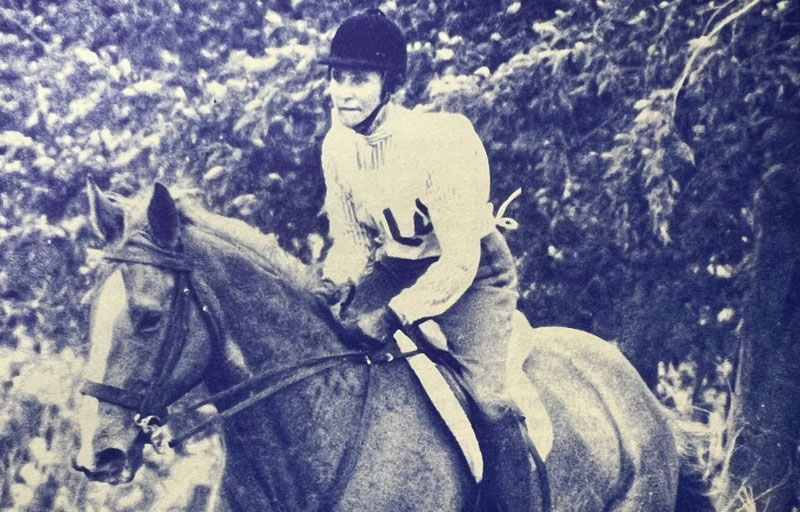
(now called USPC Festival). Reprinted from Pony Club News
A landmark change for Pony Club was the addition of the Pony Club Festival in 1983. The inaugural Festivalwas held at the Kentucky Horse Park from August 10-14. Conceived by then-USPC President Marylou Anderson and led by Vice President for Activities Bob Sykes, as he served as Chair of the Festival Committee, this event combined championships with a rich educational program. This was the first time Dressage and Know-Down (now called Quiz) had national championships, while an official Show Jumping Championships didn’t begin until the year after the first Festival. The Pony Club Festival also featured international participation, with Mounted Games teams from Canada and Great Britain adding a global dimension to the event. The USPC Games team won for the first time in 25 years!
The educational component of Festival was quite diverse with more than 50 Activities and Instruction clinics, workshops, and demonstrations. There were also three-day-long D- and C-level day camps; a C-3 test prep clinic; and test prep clinics for those testing for their A or B in Dressage, Combined Training, or Show Jumping.
The introduction of new activities further enriched the experience for attendees, with the dressage derby, pas de deux, show jumping competition, and the “Old Guard” competition for graduate Pony Club members (called a graduate back then because the maximum age for Pony Club was still 21), Regional Supervisors (RSs), District Commissioners (DCs), board members, parents, and other interested adults. All this ensured that there was something for everyone involved.
The five-day 1983 Festival also included a trade fair, a workshop for DCs designed to enhance both horsemanship and leadership skills, demonstrations in driving, polo, and vaulting (three disciplines that had USPC committees at that time), as well as parties, trail rides, a drag foxhunt and a mock foxhunt and hunt breakfast, terrier races, a Bluegrass band, and a square dance.
Notably, this first Festival attracted 900 Pony Club members and 450 horses for an impressive kickoff to this iconic event.
Continuing Festival’s Success
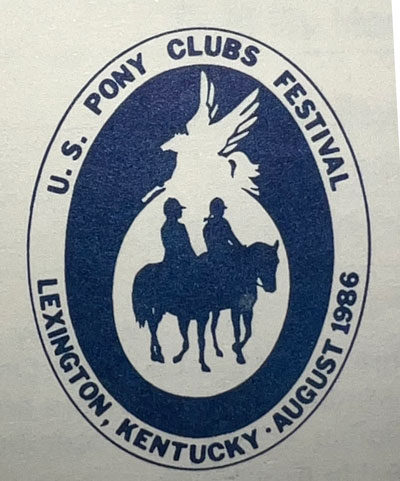
The success of the first Pony Club Festival led to its continuation every three years and subsequent expansion to every two years, starting this year. By 1986, the Pony Club Festival, led by Festival Secretary Bonnie Sheldrake, had grown to include all 25 Pony Club regions, with an even broader array of activities. The 1986 Pony Club Festival, which happened August 10-16, hosted Championships for all the competitive riding disciplines, as well as the second Know-Down Championships, which had been set for every three years during Festival. Between competition and education, the event became a family affair, with many attendees coming to Festival as their summer vacation.
Organized with the help of Festival Coordinator Edie Cassidy, the 1986 USPC Festival had top-notch instructors, including a variety of Pony Club experts all the way up to Olympians, such as Torrance Watkins-Fleischmann (Meadow Brook Hounds Pony Club), Robert Dover (Arlington-Fairfax Pony Club), and Tad Coffin (Meadow Brook Hounds Pony Club). In addition, the leadership program was offered to help DCs and RSs gain a thorough understanding of the various USPC Standards of Proficiency and how to run effective Pony Clubs.
Perhaps the most fascinating part was the rapid growth just three years later from 900 riders in 1983 to 1,350 entrants. With parents, friends, and volunteers, the total participant count was estimated at 3,500 attendees—making it a massive gathering that set the tone for future Festivals.
The third Festival in 1989, organized by the appointed Festival Coordinator Gordon Stoa, a Pony Club parent from Mission Valley Pony Club, continued with the same successful lineup of events, and the educational program was easily divided up along the Pony Club levels from D-1/D-2 all the way to C-2 topics and then test prep clinics for C-3, B, H-A, and A levels conducted by National Examiners. Opening Ceremonies highlighted the festivities.
One noteworthy change was the introduction of Polocrosse during the 1989 Festival. This discipline had only been introduced into the United States a few years prior. Clinics were held several times each day, with exhibition games in the afternoons. Each clinic had 30 to 50 participants with both children and adults.
The Push for Safety and Better Horse Management
While the 1970s saw the beginning of USPC’s leadership in rider safety, including the study of protective headgear for horseback riders and the development of specific helmet criteria, the 1980s continued to be a time of increased focus on safety within Pony Club. Dru Malavase, a key figure in USPC’s safety efforts over the years, led a special committee of the American Society of Testing and Materials (ASTM) to develop standards for safer riding helmets. This work culminated in 1990 when Pony Club became the first organization to require helmets approved by the Safety Equipment Institute (SEI). SEI officially replaced the original “Pony Club headgear standard” established in 1983, as it took over as a completely independent testing, certification, and quality control program.
The year 1980 became the first full year that the Incident Report Forms were due from DCs after any safety incident, and those forms are still collected to this day for the analysis of safety data.
Leadership Changes
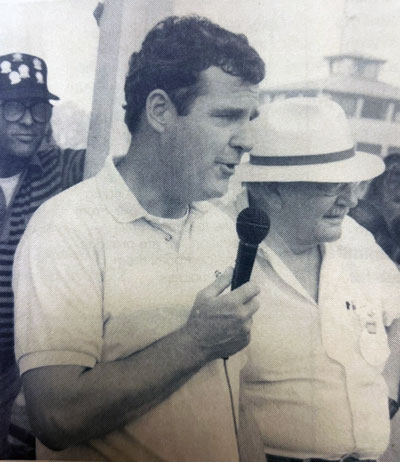
Reprinted from Pony Club News
Leading into the 1980s was President Jim Ligon, the first alum to hold the position, who would again take the helm in 1987. Jack Fritz became President in 1981, followed by Marylou Anderson, the first woman to hold the position since Louise Bedford. Anderson’s tenure was marked by significant developments, including the creation of the Strategic Planning Committee and the position of Vice President for Strategic Planning, first held by Cynthia (Cindy) Piper. Pony Club parent Anson Taylor, who had served as USPC legal counsel since 1979, served a short stint as president in 1986 before Ligon took the role on again. And in July 1989, Robert (Bob) Kutil, former DC of Limestone Pony Club in the Western New York Region, stepped up for an early nomination to the role.
The leadership transitions of the 1980s also saw the retirement of George Helwig, the long-serving Executive Director who helped the organization become more professional and standardized. During his 11-year tenure, Pony Club News began publication, training seminars for Examiners and Horse Management Judges were established, the number of clubs doubled, and iconic events like Festival were successfully launched. Helwig became known for his many travels to clubs and regions across the country and for his direct involvement in many activities. He also became involved in fundraising and public relations, helping to introduce Pony Club to potential sponsors and possible new members. He has also provided continuity to a volunteer organization in which an average of one-third of its volunteers were new each year at that time. In this regard, Helwig has played a key role in helping to recruit new leaders.
During the 1980s, the USPC office was headquartered in West Chester, Pa., and manned by a small Professional staff.
Staffing the Office
Since I’m on the USPC staff, I’m most fascinated with the staff notes, news about the National Office, and also about the progression of Pony Club News/now Discover USPC, which is the publication I put together and edit. How did we grow to where we are today…now at almost 20 staff members in 2024? I’ve separated this information out into “United States Pony Clubs Staff Over the Years,” since it will get updated as we review future decades.
Lasting Developments
A comprehensive two-year review of the new Standards of Proficiency was released in 1980. While that was done by the Instruction Council, the Activities Council committees were busy governing the competition disciplines of Combined Training, Dressage, Mounted Games (then called Games), Tetrathlon, and Show Jumping.
Tetrathlon was the fastest-growing discipline with 11 regions holding competitions. Several alumni became competitive within modern pentathlon, such as Kim Dunlop of Ochlockonee River Pony Club, who joined the U.S. Women’s Modern Pentathlon team and competed in the summer of 1979. Julie Foster, of Groton Pony Club, qualified during July 1980 for the Women’s National Pentathlon Championships, but Dunlop won that year. Both would go on to join the U.S. Women’s Modern Pentathlon team. Tony Pratt, also of Groton Pony Club, was a leading men’s pentathlete.
For Know-Down, Betty Martin and the Know-Down Committee began preparing a “Know-Down Bank” of questions separated by level from D-1 to B.
The decade saw significant progress in the development of the USPC’s Standards of Proficiency. Ruth Ring Harvie and Dru Malavase meticulously researched and documented each item in the Standards, ensuring that they were comprehensive and up-to-date. Instructional videos for C-3 through A levels were produced, providing members with valuable resources to improve their skills. We have Joan Ketcham, Bev Chester, Betsey Reeves, Deb Willson, and Judy Fannin’s dedicated work to thank for these videos.
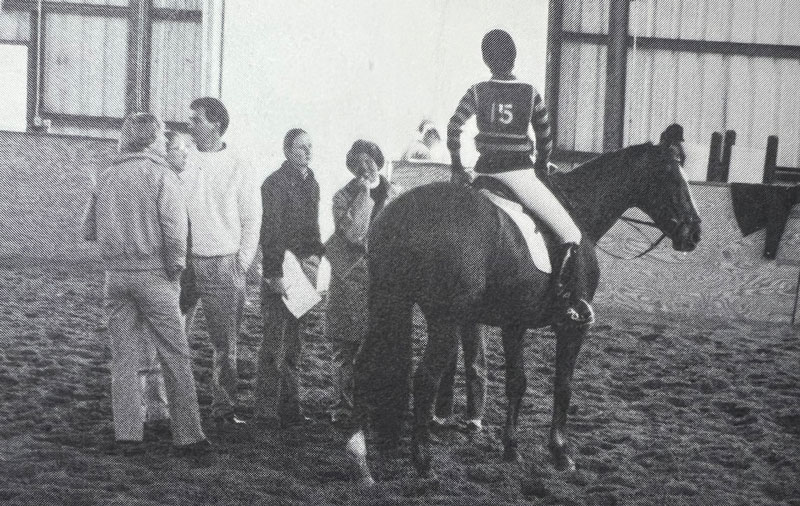
Beth Dowd compare their assessments of riding skills demonstrated at the third
National Examiners’ Seminar in 1988. Reprinted from Pony Club News
In 1985, 42 National Examiners attended the first USPC National Examiner’s Seminar in Gaithersburg, Md., and agreed to meet yearly. This seminar is now conducted annually via Zoom, with a much larger attendance.
The Horse Management Committee, led by Laurie Chapman-Bosco, also made strides in standardizing and improving Horse Management judging. The introduction of the first Horse Management Judges Seminar in 1988 saw 45 attendees from Hawaii to Maine converge in Baltimore, Md., to focus on the revision of the Horse Management Handbook, first written by alum and lifelong USPC volunteer Ben Duke, who would later become president of USPC from 2018-2022). These efforts overhauled scoring and included guidelines for Horse Management Judging for all competitions and the introduction of evaluation forms for judges, organizers, and competitors to use to provide feedback. These are also in use today.
Another publication created in the 80s that is still in use is the National Examiner’s Handbook, first created by the National Testing Committee led by Chris Krasa, to clarify the upper-level exams for NEs and DCs, as well as the candidates.
In 1988, during the USPC’s 34th Annual Meeting, held January 28-31 in Kansas City, Mo., the first annual presentation of the Founders Awards were presented. Each year, this award is still presented to one or more people who have made a significant contribution to USPC. The first award went to Alice Sherburne Reidy, who died several months later, and W. Sidney Felton, Esq., who was the original writer of the USPC constitution and bylaws upon its founding as a 501(c)(3) organization in 1954.
Also in 1988, the Uniform Officiation Rules were released, meaning that certain Horse Management Rules applied to all disciplines, which helped with standardization.
As for the USPC Annual Meeting, it was held for the first time on the West Coast in 1987. Held at the Red Lion Inn in Seattle, Wash., it was the year the first Strategic Plan was released. The first Strategic Plan covered Education, Growth, Administration, Recognition/Marketing, Communications, Finance, Competition (with other organizations), and Leadership. Also out of that plan, two new roles were created: Vice President of Communications with Jim Winsor and Vice President of Membership Development with Marylou Anderson.
Pony Club at the Olympics
The 1980s saw an increase in participation from former Pony Club members in the Olympic Games across all three equestrian disciplines. In 1980, several Pony Club graduates were selected for the U.S. Olympic Equestrian Team, including Combined Training rider Michael Plumb, Jumping Team member Melanie Smith, and Dressage rider Lendon Gray.
The 1984 Summer Olympics in Los Angeles, which were televised with commentary from former Olympian Tad Coffin, were particularly successful for the U.S. Equestrian Team, which included many former Pony Club members. The Three-Day Event Team, featuring alumni Bruce Davidson and Plumb, won the Team Gold medal, while Karen Stives earned an Individual Silver medal in Eventing. The Show Jumping team also secured a Team Gold medal, with Smith playing a key role.
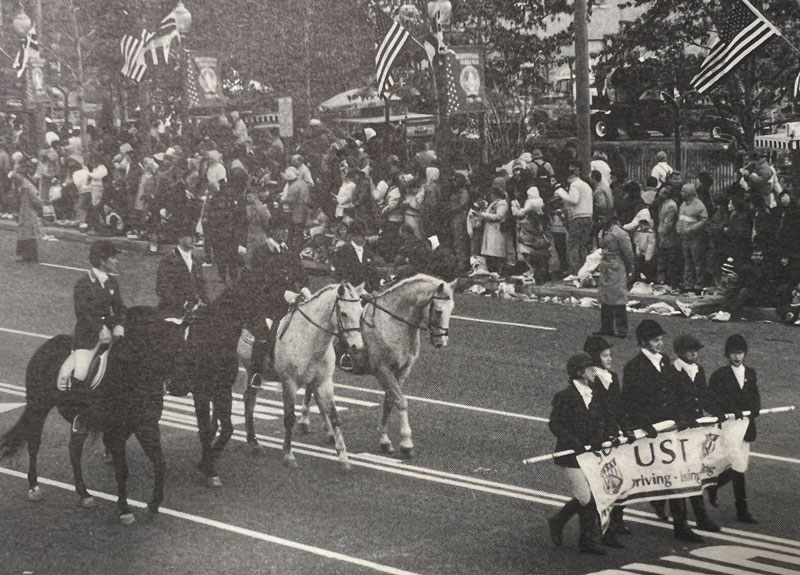
By 1988, Pony Club alumni continued to dominate the U.S. Three-Day Event squad, with riders like Davidson, Stives, and newcomer Karen Lende, who many better recognize by her married name of O’Connor, all representing the country at the 1988 Seoul Olympics. These achievements underscored the Pony Club’s role in developing top-tier equestrian talent, which would continue with Karen and David O’Connor’s winning streak in the 1990s as they became some of the most recognizable alumni of Pony Club among Eventing fans.
The Awesome Eighties
The 1980s were a pivotal decade for the Pony Club, marked by significant advancements in competition, safety, education, and leadership. The establishment of the Championships and the Festival created new opportunities for members to showcase their skills and learn from the best in the field. The focus on safety, particularly with the introduction of SEI-approved helmets, set new standards for the organization and the broader equestrian community.
Leadership during this period was instrumental in driving these changes, and achievements of Pony Club graduates at the Olympic Games further highlighted the organization’s success in nurturing exceptional equestrian talent.



